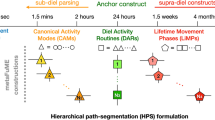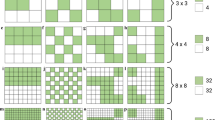Abstract
Animals live in an environment that is patchy and hierarchical. I present a method of detecting the scales at which animals perceive their world. The hierarchical nature of habitat causes movement path structure to vary with spatial scale, and the patchy nature of habitat causes movement path structure to vary throughout space. These responses can be measured by a combination of path tortuousity (measured with fractal dimension) versus spatial scale, the variation in tortuousity of small path segments along the movement path, and the correlation between tortuousities of adjacent path segments. These statistics were tested using simulated animal movements. When movement paths contained no spatial heterogeneity, then fractal D and variance continuously increased with scale, and correlation was zero at all scales. When movement paths contained spatial heterogeneity, then fractal D sometimes showed a discontinuity at transitions between domains of scale, variation showed peaks at transitions, and correlations showed a statistically significant positive value at scales smaller than patch size, decreasing to below zero at scales greater than patch size. I illustrated these techniques with movement paths from deer mice and red-backed voles. These new analyses should help understand how animals perceive and react to their landscape structure at various spatial scales, and to answer questions about how habitat structure affects animal movement patterns.







Similar content being viewed by others
Notes
Computer programs to carry out all of these calculations can be freely downloaded by contacting the author
References
Benhamou S (1989) An olfactory orientation model for mammals’ movements in their home ranges. J Theor Biol 139:379–388
Benhamou S (1990) An analysis of movements of the wood mouse Apodemus sylvaticus in its home range. Behav Process 22:235–250
Berggren A, Birath B, Kindvall O (2002) Effect of corridors and habitat edges on dispersal behavior, movement rates, and movement angles in Roesel’s bush-cricket (Metrioptera roeseli). Conserv Biol 16:1562–1569
Blackwell PG (1997) Random diffusion models for animal movement. Ecol Model 100:87–102
Blums P, Nichols JD, Hines JE, Lindberg MS, Mednis A (2003) Estimating natal dispersal movement rates of female European ducks with multistate modelling. J Anim Ecol 72:1027–1042
Boonstra R, Craine ITM (1986) Natal nest location and small mammal tracking with a spool and line technique. Can J Zool 64:1034–1036
Cain ML (1985) Random search by herbivorous insects: a simulation model. Ecology 66:876–888
Edenius L (1997) Field test of a GPS location system for moose Alces alces under Scandinavian boreal conditions. Wildl Biol 3:39–43
Efron B, Tibshirani R (1991) Statistical data analysis in the computer age. Science 253:390–395
Fauchald P, Tveraa T (2003) Using first-passage time in the analysis of area-restricted search and habitat selection. Ecology 84:282–288
Fritz H, Said S, Weimerskirch H (2003) Scale-dependent hierarchical adjustments of movement patterns in a long-range foraging seabird. Proc R Soc Lond B 270:1143–1148
Halley JM, Hartley S, Kallimanis AS, Kunin WE, Lennon JJ, Sgardelis SP (2004) Uses and abuses of fractal methodology in ecology. Ecol Lett 7:254–271
Johnson CJ, Parker KL, Heard DC, Gillingham MP (2002) Movement parameters of ungulates and scale-specific responses to the environment. J Anim Ecol 71:225–235
Jonsen ID, Myers RA, Flemming JM (2003) Meta-analysis of animal movement using state-space models. Ecology 84:3055–3063
Kareiva PM, Shigesada N (1983) Analyzing insect movement as a correlated random walk. Oecologia 56:234–238
Krummer JR, Gardner RH, Sugihara G, O’Neill RV, Coleman PR (1987) Landscape patterns in a disturbed environment. Oikos 48:321–324
Lathrop RG Jr, Peterson DL (1991) Identifying structural self-similarity in mountainous landscapes. Landscape Ecol 6:233–238
Lemen CA, Freeman PW (1985) Tracking mammals with flourescent pigments: a new technique. J Mammal 66:134–136
Lewis MA, Murray JD (1993) Modelling territoriality and wolf-deer interactions. Nature 366:738–740
Mårell A, Ball JP, Hofgaard A (2002) Foraging and movement paths of female reindeer: insights from fractal analysis, correlated random walks, and Lévy flights. Can J Zool 80:854–865
Mandelbrot B (1967) How long is the coast of Britain? Statistical self-similarity and fractional dimension. Science 156:636–638
Milne BT (1991) Lessons from applying fractal models to landscape patterns. In: Turner MG, Gardner RH (eds) Quantitative methods in landscape ecology. Springer, Berlin Heidelberg New York, pp 199–235
Moen RA, Pastor J, Cohen Y (1997) Accuracy of GPS telemetry collar locations with differential correction. J Wildl Manage 61:530–539
Nams VO (1996) The VFractal: a new estimator for fractal dimension of animal movement paths. Landscape Ecol 11:289–297
Russ JC (1994) Fractal surfaces. Kluwer, Dordrecht
Saupe D (1988) Algorithms for random fractals. In: Petigen H-O, Saupe D (eds) The science of fractal images. Springer, Berlin Heidelberg New York, pp 71–113
Smith JNM (1974) The food searching behaviour of two European thrushes. 1. Description and analysis of search paths. Behaviour 48:276–302
Stamps JA, Krishnan VV (1999) A learning-based model of territory establishment. Q Rev Biol 74:291–318
Turchin P (1996) Fractal analyses of animal movement—a critique. Ecology 77:2086–2090
Wiens JA (1989) Spatial scaling in ecology. Funct Ecol 3:385–397
With KA (1994) Using fractal analysis to assess how species perceive landscape structure. Landscape Ecol 9:25–36
Acknowledgements
This work was supported by the Natural Sciences and Engineering Research Council of Canada. I thank M. Nams for editorial assistance.
Author information
Authors and Affiliations
Corresponding author
Rights and permissions
About this article
Cite this article
Nams, V.O. Using animal movement paths to measure response to spatial scale. Oecologia 143, 179–188 (2005). https://doi.org/10.1007/s00442-004-1804-z
Received:
Accepted:
Published:
Issue Date:
DOI: https://doi.org/10.1007/s00442-004-1804-z




